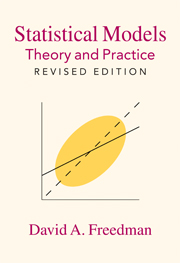Book contents
- Frontmatter
- Contents
- Foreword to the Revised Edition
- Preface
- 1 Observational Studies and Experiments
- 2 The Regression Line
- 3 Matrix Algebra
- 4 Multiple Regression
- 5 Multiple Regression: Special Topics
- 6 Path Models
- 7 Maximum Likelihood
- 8 The Bootstrap
- 9 Simultaneous Equations
- 10 Issues in Statistical Modeling
- References
- Answers to Exercises
- The Computer Labs
- Appendix: Sample MATLAB Code
- Reprints
- Index
10 - Issues in Statistical Modeling
Published online by Cambridge University Press: 05 June 2012
- Frontmatter
- Contents
- Foreword to the Revised Edition
- Preface
- 1 Observational Studies and Experiments
- 2 The Regression Line
- 3 Matrix Algebra
- 4 Multiple Regression
- 5 Multiple Regression: Special Topics
- 6 Path Models
- 7 Maximum Likelihood
- 8 The Bootstrap
- 9 Simultaneous Equations
- 10 Issues in Statistical Modeling
- References
- Answers to Exercises
- The Computer Labs
- Appendix: Sample MATLAB Code
- Reprints
- Index
Summary
Introduction
It is an article of faith in much applied work that disturbance terms are IID—Independent and Identically Distributed—across observations. Sometimes, this assumption is replaced by other assumptions that are more complicated but equally artificial. For example, when observations are ordered in time, the disturbance terms ∈t are sometimes assumed to follow an “autoregression,” e.g., ∈t = λ∈t−1 + δt, where now λ is a parameter to be estimated, and it is the δt that are IID. However, there is an alternative that should always be kept in mind. Disturbances are DDD—Dependent and Differently Distributed—across subjects. In the autoregression, for example, the δt could easily be DDD, and introducing yet another model would only postpone the moment of truth.
A second article of faith for many applied workers is that functions are linear with coefficients that are constant across subjects. The alternative is that functions are non-linear, with coefficients (or parameters more generally) that vary across subjects. The dueling acronyms would be LCC (Linear with Constant Coefficients) and NLNC (Non-Linear with Non-constant Coefficients). Some models have “random coefficients,” which only delays the inevitable: coefficients are assumed to be drawn at random from distributions that are constant across subjects. Why would that be so?
These articles of faith have had considerable influence on the applied literature. Therefore, when reading a statistical study, try to find out what kind of statistical analysis got the authors from the data to the conclusions.
- Type
- Chapter
- Information
- Statistical ModelsTheory and Practice, pp. 209 - 218Publisher: Cambridge University PressPrint publication year: 2009



